Product Review: Sonax Nano Tech Paint Cleaner (NTPC)
by Todd CooperiderSonax is mostly recognized here in the U.S. for industry-leading technology in their Full Effect Wheel Cleaner, but what many people may not realize is that Sonax has been in business since 1949, and they produce a wide range of professional detailing products. While their presence here in the North American market may have only covered the past few years, Sonax has a long history of designing, developing, and manufacturing very high quality detailing products out of their Neuburg, Germany headquarters.
I originally met the Sonax company personnel at the SEMA Show out in Vegas in the Fall of 2010, and their presence at the show immediately gave me a good indication of (a) how big this company really is, and (b) how dedicated they are to the detailing industry. While I was at the show I spent a little time with Tom at Sonax USA, and we agreed to talk further in the future so that we could test some products for the Detailed Image Ask A Pro Blog.
Fast forward to this past Spring…Tom and Jason from Sonax USA came over to the Esoteric Auto Detail studios here in Columbus, Ohio for a visit. We looked at some Ferraris and Lamborghinis, talked shop, and then they introduced me to some products in their lineup that I may be interested in. Since they’re so new to the North American market, I wasn’t overly familiar with some of the products that they had to offer…I get so many products to test that I simply can’t try and know them all. During our meeting they talked about the Sonax philosophy to develop and produce detailing products with exceptional performance, ease of use, and be environmentally friendly as well. Since they went through so much effort to reach out to me and the other blog authors and readers, I figured I would give the products a shot. They left me with a box of samples, and it was up to me to fit the trials into my schedule.
Sonax Nano Tech Paint Cleaner – What It Is
NTPC is an All-In-One (AIO) product that cleans, polishes, and protects painted or clearcoated surfaces either by hand or by machine application. It utilizes ultra-fine abrasive polishes to restore weathered and worn finishes, and then it contains a carnauba wax that leaves behind a protective barrier once applied. Now typically when the detailing world sees the term “Paint Cleaner”, they immediately think of a consumer-grade hand polish that you can buy for $5 at the local auto store. And because of that, most people would never pick it up and give it a try because of what the product is classified as. Are enthusiasts and professionals alike justified in this thought process? Read on…
Let the NTPC trial begin
I was working on a beautiful Ferrari 430 Scuderia, and ran into a situation when cleaning up the carbon fiber engine compartment that had me trying different products to achieve the desired results. There was a haziness to it in some areas, as well as some light staining from improper products used at some point in the past. I tried regular cleaners, hand polishes, chemical AIO products…nothing really made it better. I stopped and evaluated the situation a bit, and remembered my box of samples that the boys from Sonax USA had recently dropped off. As I searched through the box, I came across the Nano Tech Paint Cleaner. Hmmm, maybe I’ll give this a try…nothing else has worked so why not give it a shot!
The first spot I tried had some staining on the beautiful carbon fiber panels. I reached for a soft foam applicator pad, added a few drops of NTPC, and gently hand-polished the area. When I wiped it off with my microfiber towel, not only did I see that the staining was removed, but the area around it where NTPC was applied had transformed into a rich, deep gloss and looked as it should. Excited with my findings, I proceeded to polish out the entire panel to reveal the rich beauty of the carbon fiber. I then compared the one polished panel to the unpolished panel, and knew that Sonax was onto something with this product! I found it very easy to use and remove by hand, and proceeded with the rest of the carbon fiber in the engine compartment (there’s a lot of it on the Scuderia!). When I finished, I quickly grabbed my camera to take some shots knowing that I wanted to share this in the future. I hadn’t started out with a product test / trial in mind, but it immediately turned into one.
And here is the carbon fiber engine compartment of the Ferrari 430 Scuderia after polishing with Sonax NTPC
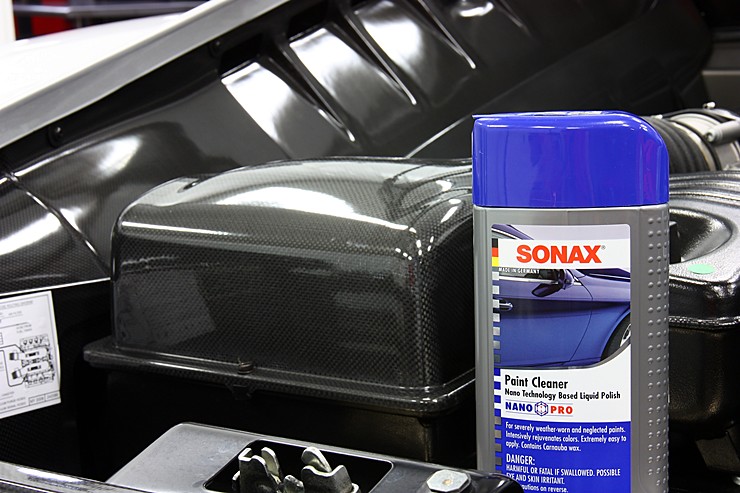
Notice the deep, rich reflections on the carbon fiber after using NTPC

And one of my favorite photos that I have ever taken…
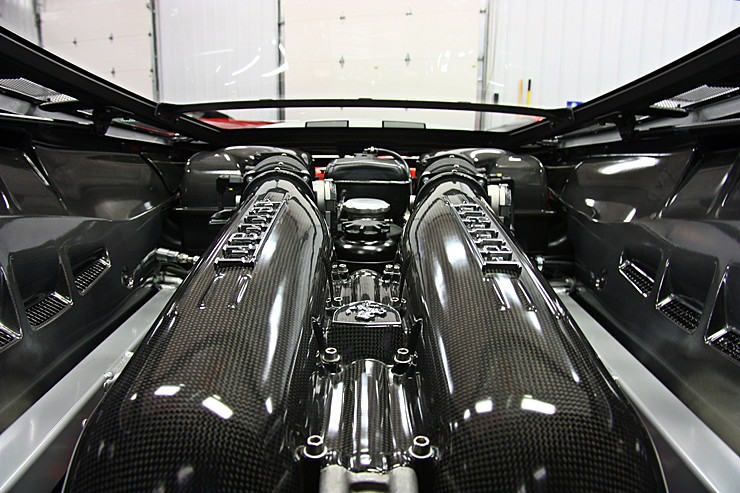
So now that I had a very successful trial of the NTPC on carbon fiber, I was intrigued by the product and anxious to try it in other applications. Next up was my epic 24-hour detail on a Lamborghini Gallardo, and I knew there would be opportunities to try it on this car.
Once again using a soft applicator pad, I used NTPC by hand in the door jambs and under the trunk lid. As with the carbon fiber, it did a great job of cleaning up the surface, removing light haze, restoring gloss, and leaving a smooth and slick finish thanks to the carnauba wax included in the formula.
Applying to the door jambs
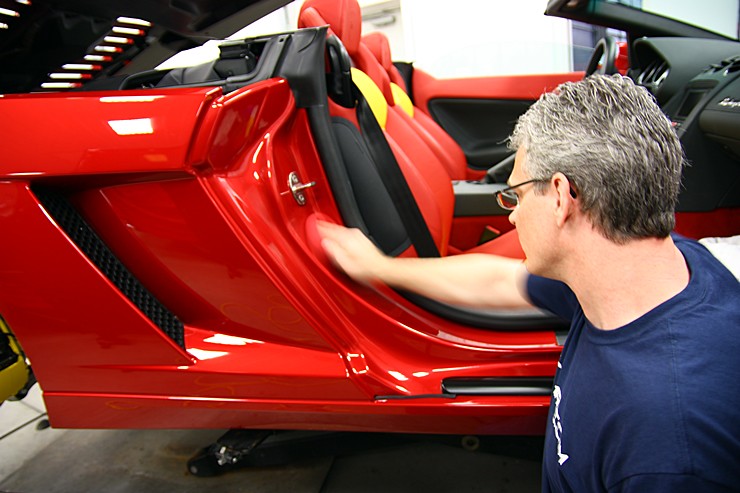
And on the underside of the trunk lid
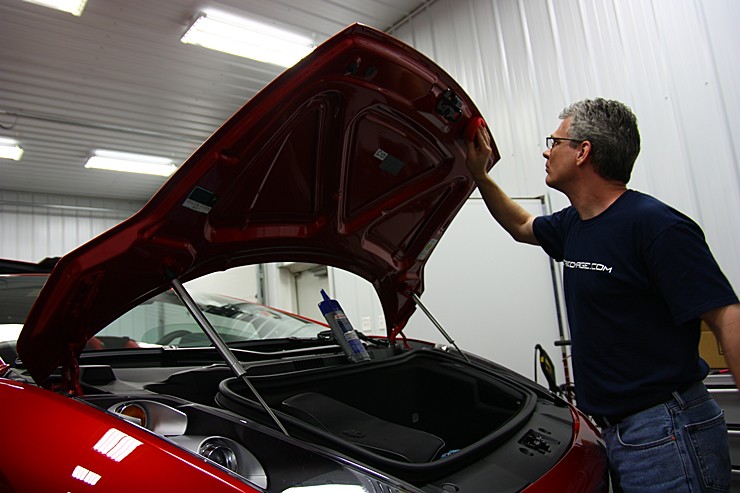
Leaving a glossy finish and a layer of protection

Using Sonax Nano Tech Paint Cleaner by machine
When using a traditional “paint cleaner”, it’s assumed that the process will be done by hand. I used the hand-application process on carbon fiber, on door jambs, and even on the exterior painted surfaces with very good results. At that point I was already prepared to do a writeup limited to just those very applications. But the next method and trial came out of chance, and in the process I discovered where NTPC really shines…when applied by a random orbital D/A polisher!
I was working on a black Ferrari 355, and the owner just wanted a quick polish to lightly clean it up…nothing major. I knew that the pure black Ferrari paint was soft and at times very challenging to work with, and figured that there would be a bit of testing to figure out what product and pad combination would net me the most correction with the best finish in the least amount of time.
When dealing with soft paints (dark, and black colors in particular), you’re typically faced with a different set of challenges than you’ll face with others. Medium-level polishing is usually out of the question because you’ll experience marring, holograms, or D/A haze depending on the process you’re using. Given that, you just have heavy, multi-step correction or very light polishing to choose from. And on some very soft and finicky paints, even using the absolute finest polishes and pads can leave marring on the finish. Some of these can only be seen when using a direct light source like the Brinkmann LED, but it’s still there. Getting ultra-soft paint to finish down properly is one of the most challenging situations that detailers and enthusiasts can face, and if you don’t have the right selection of products and tools, you may walk away from the job frustrated because you simply can’t get that ultra-pure finish that you were trying for.
As I started on this very soft black Ferrari, I tried several different products and combinations and just wasn’t getting the results that I wanted. Meguiar’s M205 left a tremendous amount of haze, and their D301 Finishing Wax wasn’t much better. This isn’t a knock against those great products…just pointing out that even finishing polishes can be too aggressive for these types of paint. I then tried my old stand-by polish for these applications…Optimum Poli-Seal. Once I looked under the Brinkmann light, I still noticed a slight haze. Hmm. In cases like these you sometimes have to step out of the box and try something completely different. And in this case, I figured I would give the Sonax NTPC a try on the D/A. I tried a few different methods, but found when I used just speed 3.5 with light pressure, it gave me the best results. All I needed was two small drops of the polish to work a good sized area. The polish doesn’t need to be “broken down” like traditional polishes, so the process goes pretty quickly.
When I wiped down my first few working areas, I pulled out the Brinkmann light for a close inspection. I was quite impressed that not only did I remove probably 50% of the light defects and haze with just a black finishing pad, light pressure, and speed 3.5, but it left no D/A haze or “squigglies” that can wreak havoc on soft black paint. I did a 50/50 (alcohol/water) wipedown on a small area just to be sure, and still found a pure finish. On an important note…alcohol wipedowns on soft black paint can cause its own marring and/or scratches…I wouldn’t recommend using it on this type of paint if you don’t have to!
Here I taped off a section and you can see that the area on the left has been corrected with NTPC, and the right side is the very hazy and swirled condition before polishing.
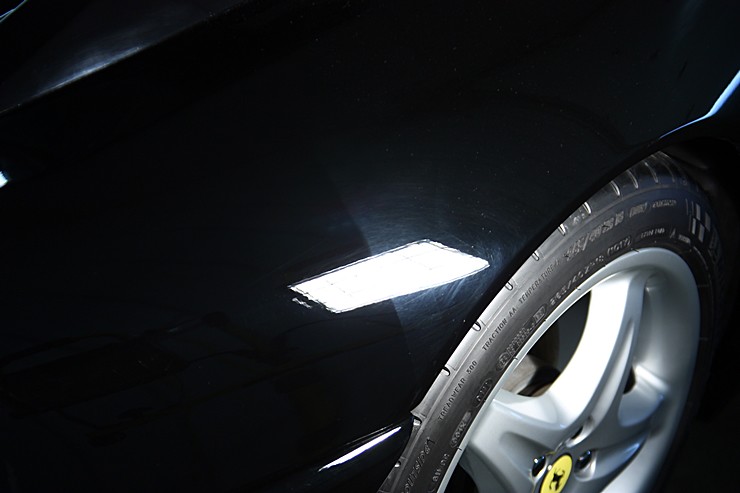
Normally with paint like this you can spend many, many hours with a frustrating polishing process to achieve even a 50% correction rate and this level of gloss. For this Ferrari 355, I invested only about 2 hours worth of light polishing time to achieve this:

While not perfect, this Ferrari now looks absolutely amazing with very little effort in a one-step polish.
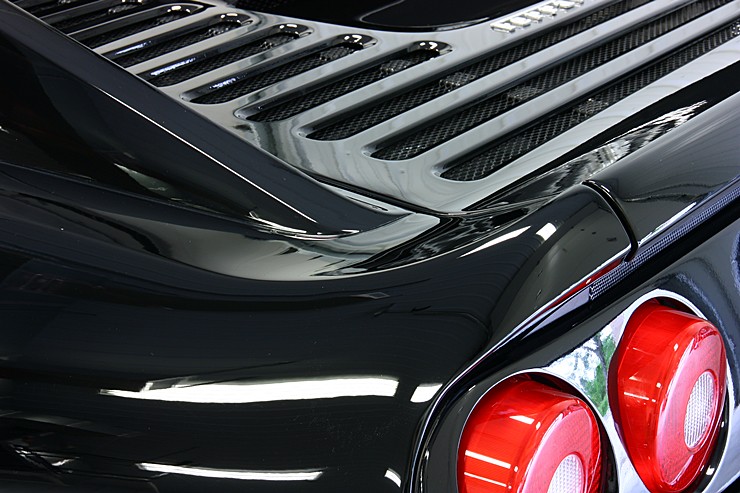
Now sticking with the theme of quick, effective, one-step polishes by D/A on ultra-soft paint, I once again put the NTPC through a test on this 1994 Acura NSX. These cars have even softer and more finicky paint than the Ferrari, and figured it would be a great test. We were only doing a one-step polish on this car, and wanted to get the most cut with the best finish in the least amount of time. My first test was with Optimum Poli-Seal, and as expected, it left a light marring on the finish. I switched over to the NTPC with a black finishing pad on speed 3.5, and began the process. Once again…pure finish, great depth and gloss, and most importantly of all no haze or squigglies. With this soft paint, I achieved probably 75% correction in just a few short hours thanks to Sonax.
While I didn’t get any “before” photos, you can see that this Acura NSX had an incredible amount of depth and gloss after polishing with NTPC.


More soft, black cars!
I’ve tried Sonax on clearcoat systems, but what about soft single stage paints? I had a 1991 Ferrari Testarossa in the shop and I saw that as a great test vehicle for single stage paints. When this car came in, it was covered in such a heavy haze that it looked grey in the right lighting. This was a 20 year old car, and the soft paint was looking very worn and tired with no impact at all. Black paints should scream “look at me” with a high gloss and reflectivity, but this Ferrari just didn’t have that going for itself.
I did two tests on this one…polishing the paint by hand, and by machine. When polishing the paint by hand using NTPC, there was a huge difference in the amount of gloss and depth of color. It also corrected the slight haze pretty easily. So if somebody wanted to use NTPC by hand on soft paints, they can still expect a noticeable difference. When I switched over to using the D/A polisher (black pad, speed 3.5), it took that correction to another level. Not only did I get rid of probably 50% of the light defects, but it added a richness to the color that had to be seen to believe. This car was turning into one with a deep, black, glossy finish that it hadn’t seen in a long, long time. It was almost like it was “black in a bottle” that I was applying to the finish. While the car still had plenty of deep scars and scratches (that would require probably 20-25 hours worth of heavy polishing to remove), the color, clarity, gloss, and reflections that this car now produced would rival just about anything at a car show…in only about 2 hours worth of work!
Here you can see a 50/50 shot of a test section when polished by the D/A.

And when you remove all of that greying-haze, you’re left with a high gloss finish that looks like this:

And outside:
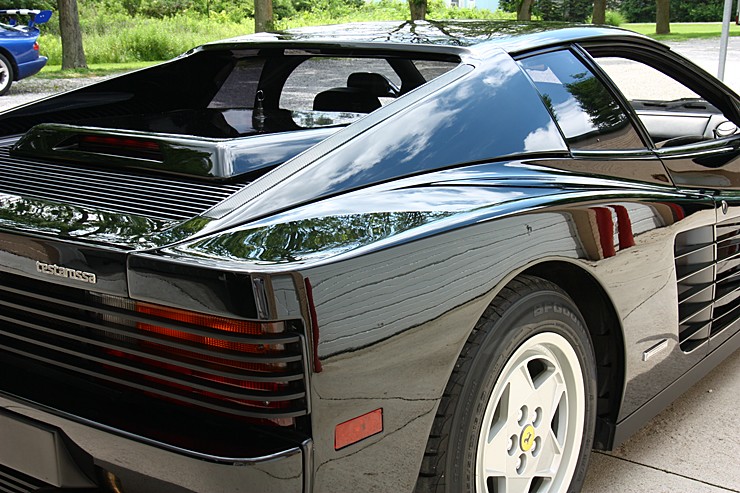
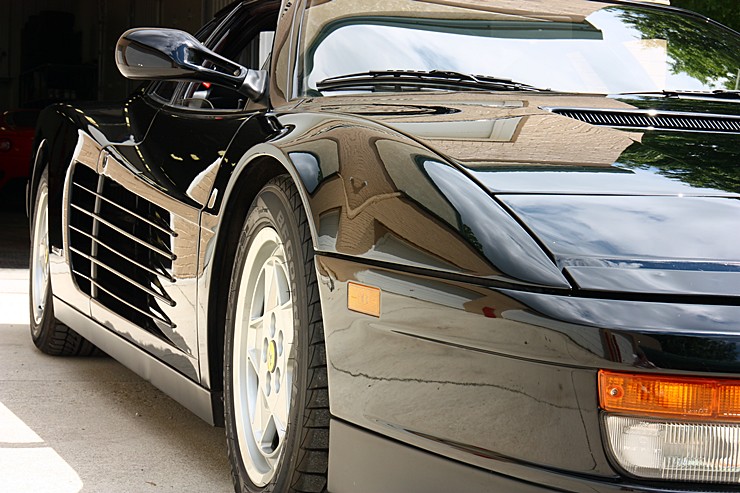
Even in overcast conditions:
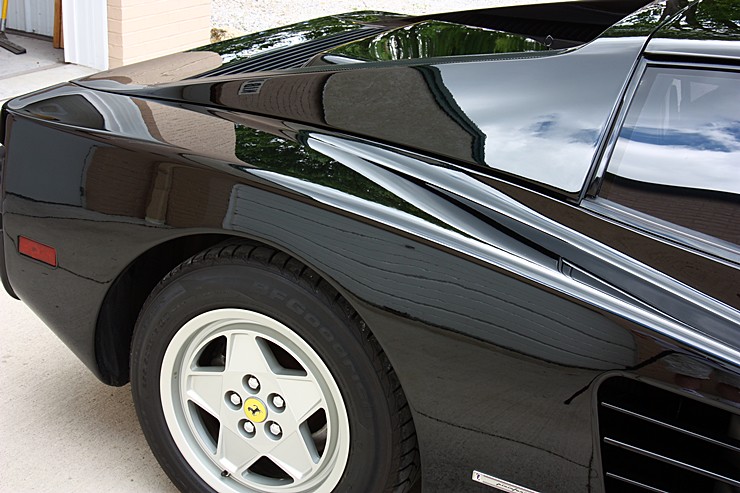
OK then, what about using NTPC in multi-stage polishing processes?
I’ve tested it by hand on various surfaces, I tested it by machine in quick one-step polishing, and now it was time to try it in a multiple step polishing process. I was working on a Rosso Corsa Ferrari 355, and have done enough of these that I know what works well with them. But despite that, I saw this as an opportunity to try something completely different. The first step involved heavy compounding using the Meguiar’s Microfiber Cutting Discs and D300 Compound. This got rid of all of the defects, but left a bit of haze on the soft red paint. For comparisons I tried M205 and D301 Finishing Wax, and both of them left a very slight D/A haze that was noticeable under the inspection of the Brinkmann light. I grabbed for the Sonax NTPC, tested it out, and after my initial findings I proceeded to finish the entire car with this combination…leaving an ultra-pure finish on the beautiful red Ferrari. While I probably couldn’t have used this process on harder paints, it was the perfect solution for the soft paint.
Here I am working with the Sonax NTPC on the engine cover of the 355 (the best way to fully correct these is to remove them from the car). And please…no comments on the white legs…there hadn’t been much sunshine here in the Midwest this early in the summer!
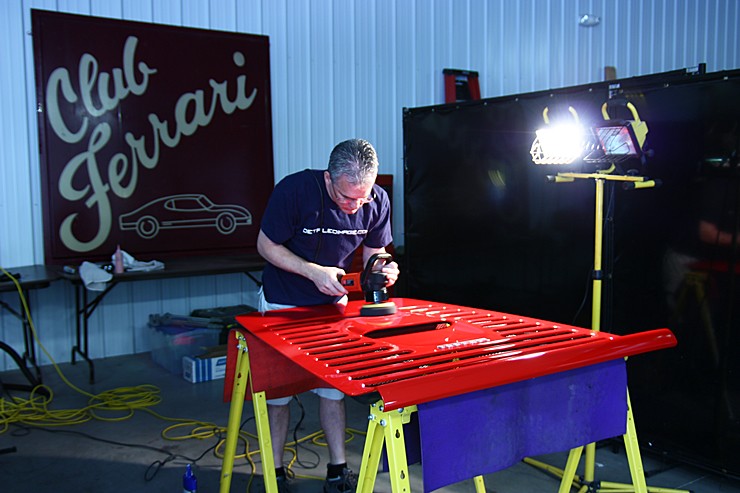
And the finished product!
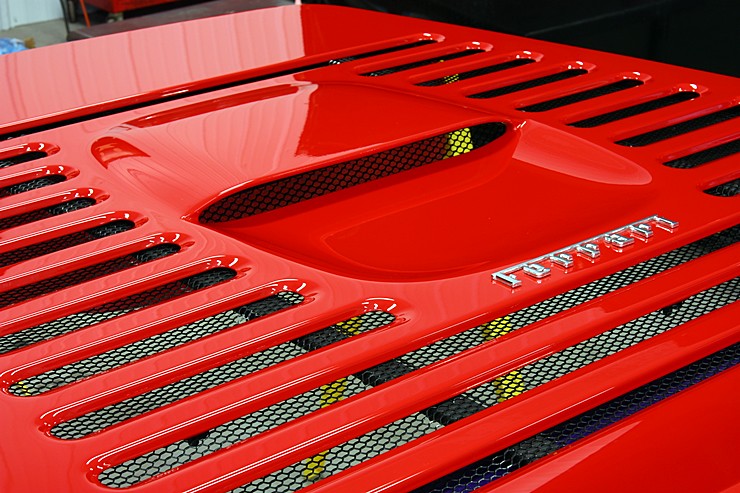
Sonax Nano Tech Paint Cleaner – The Perfect Solution for Soft Paints?
I have dealt with a lof of finicky, soft paints…the ones that can make you lose sleep because they require so much effort and trial and error to get them right. And not every soft paint works the same so when you have a system dialed in for one particular paint, it may (and usually does) require a totally different method and combination for another.
It’s just worked out that I have had a run of soft paints here in the Esoteric Studios, and it has given me a great opportunity to spend a lot of time with Sonax NTPC. So given the stellar results I have had, does it make this product the perfect solution for these finicky soft paints? Well, there are so many different cars and paints out there, so I couldn’t make such a bold claim. But I can say that with the paints I’ve been dealing with lately, it has been the perfect solution for what I have been trying to accomplish. Sure I most likely could have gotten similar results with a rotary and something like Menzerna PO85RD, but it would have taken 2 to 3 times as much effort and time to do it. And with some of these paints, I have found that combination even to leave the slightest marring or swirls (hence the term “finicky” paint!). And since most enthusiasts and many detailers don’t even use the rotary, it makes the option of using NTPC on a D/A machine (or by hand) an even better one.
Final Thoughts on Sonax NTPC
Pros:
- Extremely versatile. Can be used by hand or by machine…paint, door jambs, carbon fiber, etc.
- AIO product…cleans, polishes, protects
- Amazing results with a D/A polisher on ultra soft, dark paints.
- Relatively easy to use. A little bit of product goes a long way.
- Contains a carnauba wax so that no other steps are necessary.
Cons:
- Can be difficult to remove at times if product isn’t fully worked in. I recommend polishing one section, then removing, then moving on to next section.
- Bottle easily tips over! It’s a tall, slender bottle and as I moved my way around the car on my work cart, I probably knocked the bottle over a half a dozen times. I then transferred the product over to an easier to handle york-style dispenser.
- Contains carnauba wax. Some people may want to finish the process with a sealant, and there could be a bonding issue because of it. If you topped this with another carnauba wax however, you should be fine.
- Now everybody is going to know about it, and I’ll no longer have the advantage!
As you can tell, despite a few items listed in the “cons” category, I’ve given this product a glowing review. I believe that Sonax Nano Tech Paint Cleaner is one of the best kept secrets out there in the detailing world right now, and while I could have easily kept it as my own trade secret, I felt it was my responsibility to share it with the industry of both professionals and enthusiasts. While it may not have such stellar results on hard paints, it sure does work wonders on softer paints (Japanese, Porsche’s, and just about anything that is a pure black). And the fact that it can be used effectively both by hand and machine on a multitude of finishes just makes this product so much better.
I am usually very critical on my product selection and am always looking at results and ease of use. If I find a product that I really like, I make it a permanent part of my detailing arsenal, and share it with the world accordingly. Sonax Nano Tech Paint Cleaner is one of those products!
So don’t get yourself caught up in the category of “Paint Cleaner”, as this product is much, much more than that. Whether you’re an enthusiast taking care of your own car, or a professional detailer managing many cars…you should seriously consider adding this product to your lineup and learning just how well it works in so many different applications.
If you have any questions or comments on the product or processes, please leave them in the comment box below. Thank you!












Just bought this product a couple weeks ago, was anxious to use it and since my car also has very soft black paint, I am going to give it try!! Good write up Todd!!
Thanks Adam…be sure to let us know what you think.
Hi Todd – Thank you for a great review and I agree with you on the Ferrari engine picture, it is just awesome. Quick question, what are your findings on the longevity of the carnuba wax? Do you know what % of carnuba it has?
Thanks again for the review.
— Abi
Thanks Abi. I’d have to test this product on one of my own cars to get a feel for the product’s durability. I’m sure it’s similar to other AIO type products. I also wouldn’t get too concerned about percentages of carnauba content, especially in an AIO type product. You’re typically going to find these numbers only in a pure wax (not an AIO), and even at that those numbers can be misleading.
Good article but how does a person that just details their own cars ( not a professional detailer ) determine if their car has soft or hard paint. There are so many cars and years and paints out there…how do you tell?
Thanks
Jim
Jim,
True…and tough for detailers to know as well. This is ultimately discovered when trying to polish and seeing how the paint reacts. Sure there are generalizations: Most Japanese cars are soft, most Porsche’s are soft, most other German brands are hard (except Jet Black BMW), American cars are all over the board. But even when the same car is manufactured in several different factories you can see variations in the paint hardness. And sometimes it also depends on the year of a specific model and color as the manufacturers like to change the paints up from time to time.
So if you don’t know the definitive answer (BMW Jet Black is soft, for instance), then you find out the same way as the detailer. You start to work with a light polish like NTPC, and if you see a big difference with a little effort, then you know the paint is soft. If you’re just adding gloss, and even the lightest haze isn’t being removed, then you know that it’s hard.
Todd, I have a couple questions about it’s application. How much pressure did you apply while working it in? And what kind of arm speed were you using? Was it as slow as when using a traditional polish, or was it a little quicker, similar to applying something like EZ-Creme?
Peter,
Just light to light/medium pressure is all that is required, and at a relatively slow arm speed. It’s not as slow as you would with a traditional polish, but defiitely not as fast as you would with a glaze. The best advice on pressure is to test it on a particular car, and see what nets you the best results for that vehicle on that day.
Hello Todd
Excellent pictures. What is the difference between this NTPC and Sonax Premium Class Paint Cleaner?
Sonax products are great
Regards
Art
Art,
The NTPC uses non-diminishing abrasives, which provide a quicker cut with less effort. Premium Class uses diminishing abrasives so you have to work the polish to break it down before you can achieve as much gloss or correction. NTPC also contains a carnauba wax, whereas Premium Class is simply a traditional paint cleaner leaving no protection (some people will prefer this depending on their desired next step or product application).
Hi Todd,
Thanx for such a help I started a detailing business in Asia I want to know how can I find out difference bitween SOFT paint & HARD paint or MEDIUM paint?
Thank you for reading & have a nice time.
Thanks for the great write up Todd. I just ordered two bottles and will be testing it out on my Acura TL 2007 which has a poor paint job (swirl marks, loss of shine, etc.). Please let me know how it works out on your Acura when you have the chance, thanks.
I definitely think you’ll like it Allen, and I too plan on testing it on my TL as well soon. Thanks!
Just wondering Todd,
What type of LC Pad would you use Sonax on a soft black paint like Honda’s with a D/A Porter Cable?
And since it’s a AIO, would you use different speeds and pressure on the PC to utilize Sonax’s capabilities as a polisher, cleaner, protector, etc?
Thanks again.
thats pretty intresting about the product being non-diminishing,sounds pretty good
David,
I’d most likely try a black LC pad. And NTPC seems to like one speed, and one pressure (which makes it easy to use).
Great review, Todd. Id love to see a larger version of that engine bay photo. Need for background.
Im really liking these non-diminishing abrasive polishs….For me they seem to work better in the sun, as diminishing abrasives dont always break down before the polish flashes…
Sorry I didnt read the entire review yet as I wanted to post….Is there any scent to the AIO?
Thanks Shane. It really doesn’t have an added scent to it…
WOW, That is nice, very impressive It really shows the quality and pride you put into your work, I am so glad I ran across one of your tweets and found this site and the Blog site, This type of Information and examples are priceless, Thanks
Thanks James!
hi todd,i tried this product out today on a couple of spots by hand and was looking for the product to haze. So i waited a couple of minute and the product was still wet,at this point i am thinking i used to much but considering its the first time i used it if figured it always takes alittle time to figure out a new product.is there atip or to you might have as far as waiting for it to haze[what to look for]
thanks again,i always enjoy the posts that you do.
John,
Remember that a little product goes a long way! I can use two pea sized drops on a pad to work half of a trunk lid by machine. It doesn’t really haze over like some products, even when applied very thin. Try less product and see just how far you can stretch it.
I recently purchased NTPC and tried to use the first time applying it with a rotary (don’t have a DA) and a black pad at 900 rpm. It was flash drying on me. I tried working in smaller areas and getting it off faster but then it seemed like I would steal leave a little residue. It was around 100 degrees in the shed I was working in. Is there such a thing as not working in the product good enough? Was it just the heat? Just wondering what your guesses are on the problem.
Also you mentioned doing a wipedown with 50/50 water alcohol. Whats the reason for that?
I’m sure the high temperatures had something to do with it drying so quickly, and the fact that you were using it on a rotary. It was designed to be used by hand, so slow speeds on the DA is as far as I would push this product.
The 50/50 wipedown was just to inspect the surface by removing any polishing oils or waxes to ensure I was getting a true correction. This was only needed for the test…not as a final step in the process or anything.
That Sonax paint cleaner looks like it does a great job. Its prolly ok to use as a one step right? or put a sealant on after? Kasey
Kasey,
When I use it, it’s typically as an AIO / one-step.
Hey Todd,
I enjoyed that write up on the Sonax Paint Cleaner, and I thought It might work well on my Subaru, since they say Sub’s have soft paint. Its burgundy red. any comments would be helpful.
Thanks Again
Howard
You don’t know until you actually test a product on a particular car / paint. My guess is that it would work quite well on your Subaru though.
hey todd; i just pickid up some surbuf pads along with the sonax and was wondering if they can be used for correction. i have a 07 mx-5 miata with true red paint and i have some swirls and the like. i do also have the orange pads, white,black and the blue with the porter cable. also have all the meguiar products. the sonax seemed like an interesting product from your review hence why i bought it. but i have one question, on dj review of the surbuf pad he primes the whole pad first with 105 and then puts some on the car and goes to work. on the surbuf website it says to use a little dot in the middle and then start. is it depending what product you use that will determine the amount on the pad? could you just give me a little breakdown on how much product do you put on each pad. the surbuf,orange,white and black or blue. i do get good results on my car but nothing like yours. any help would be greatly appreciated. thanks ron
Have you done any side-by-side comparisons with NTPC and Blacklight (used like an AIO)? I’ve really enjoyed using Blacklight for quick polishing jobs on softer paint, but NTPC seems like a great product. Do you like/prefer one over the other or do you think having both products would be beneficial in any detailer’s arsenal?
I think you’d want both, as they have their different strengths depending on the situation. If you try to use Blacklight on really soft paint in good condition, you could end up with a slight D/A haze. On medium to hard paints, you’d probably want to go with Blacklight instead because the process is quicker, and there’s more durability in Blacklight than there is NTPC.
Thanks for the feedback, Todd. I think I will give it a shot.
would you advise against topping this with a sealant like blackfire wd since there is some protection in NTPC?
I haven’t been able to try topping NTPC with all of the sealants to see if there are any bonding issues or not.
is it better than blacklight or the same?
It’s different! They both have their strengths. Black Light is quicker and easier to use, and is preferred for using as a LSP. NTPC provides more correction on softer paints. The specific needs of the car dictate on which one I will use.
Hi Todd,
Always feel new and excited when reading your review…Planning to get this NTPC as my rack left a room for AIO …
Compare to poli seal which i prime the black pad and use 2~3 small dot for 2 ~3 feet , can NTPC play with such idea?
BR
Kenneth
Kenneth,
You can feel free to try different methods, but the application method that I describe in this review / tutorial is what I found to yield the best results.
Hi Todd
Thank you for another great review. I will be trying out NTPC over the weekend and looking forward to great results. I’ll be detailing my own car too (VW Golf 5) and was wondering if there is an AIO product for hard paint cars that has similar effect?
Thanks
There aren’t AIO products with really aggressive abrasives that would be required for correction capability on hard paints such as your VW. AIO’s typically aren’t designed with major paint correction in mind…it’s just that some paints are so soft or easy to work with that they benefit greatly even from light polishes.
Fantastic review and replies to the inquiries, Todd! In the latter case, the feedback on Sonax NTP vs Blacklight as an AIO was very helpful. I had been considering Blacklight to ‘toiuch up’ my new-ish Jet Black BMW but now think NTP may be the better bet. I am a ‘hobbyist’ and don’t need/want to buy both unnecessarily.
Hey Todd, have you had a chance to try NTPC on your TL yet? I have same car, and color and would love to hear your thoughts.
Yes, I tried it on the TL and it does a good job for what it is. Sure it’s not going to bring it to showroom level, but it is capable of making a big impact on swirls on the soft Acura paint.
Thanks Todd, my concern was the slight haze that the Meguiar’s Microfiber Cutting Discs and D300 Compound left. It got out most of the imperfections but did leave a slight haze. I tried to polish out with Black Light, and it helped, but I still feel depth, shine and clarity can be better. Going to give the NTPC a try on one panel and see how it works out. If that doesn’t do it will try the Menzerna’s Micro Polish SF 4500. Thanks again for your valuable info!!
More info than question but I do have one… I have a NBP TL-S (soft paint). It does have one repainted panel unfortunately.. I used megs 300 and cutting pad and it did an amazing job of cleaning up 90+% of defects. After looking at the car under brinkmann light I realized that the repainted panel, although clear of any defects, had some marring and holograms. I applied NTPC with black pad on repainted area and that cleared everything up and left an absolutely amazing finish. Needles to say I applied the NTPC to the rest of the car. Car now looks like a mirror!! Used a D/A for all steps. My question is can I now wipe down the car with something like Menzerna Top Inspection Spray and then apply a sealant like Blackfire Wet Diamond or Blacklight to give more durable protection? Sorry for the book. Thanks Conrad
Hi Todd,
Have you tried the Sonax NTPC on a MF Finishing Pad using DA? I’m curious on the finish.
Dam, didn’t know about this product, thanks ! My 2001 Lexus LS430 looks as bad as the 1991 Ferrari Testarossa, I have done polish off the shelf products, it got some shine back but, did not remove the haze. I just ordered this product. I think will try a clay then followed by this stuff, it should finish out really nice.
Thank you !
Hello Todd – What about Opti-Seal? The folks at Optimum say that Opti-Seal actually penetrates carnauba waxes and “floats” the carnauba to the top layer, adding sealant protection underneath. I’ve been alternating Opti-Seal with Collinite, Wolfgang Fuzion Spray Wax, and even DodoJuice Blue Velvet. It does not dull the shine, and seems to keep extending the water beading during the winter (Oregon – rain 50in + snow and ice). Nice thing about Opti-Seal is that I’ve applied it down to 30 degrees without problems on a damp surface in a carport open on two sides with a light rain blowing.
Regardlesss – thank you for this write-up as I’ve been looking for a “cleaner wax” for jambs, engine compartments, and for hand use in tight areas.